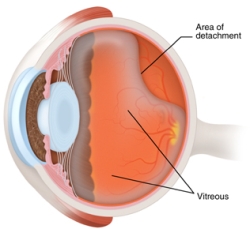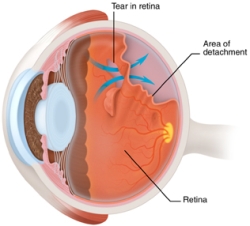Flashes & Floaters
Small specks or clouds moving in your field of vision as you look at a blank wall or a clear blue sky are known as floaters. Most people have some floaters normally but do not notice them until they become numerous or more prominent.
In most cases, floaters are part of the natural aging process. Floaters look like cobwebs, squiggly lines, or floating bugs. They appear to be in front of the eye but are actually floating inside. As we get older, the vitreous (the clear, gel-like substance that fills the inside of the eye) tends to shrink slightly and pull forward (detach) away from the retina (see below, left). Once it separates from the retina, it is more mobile. As your eye moves around, small opacities in the vitreous jelly can float in front of your line-of-sight. What you see are the shadows these clumps cast on the retina, the light-sensitive nerve layer lining the back of the eye.
The appearance of flashing lights comes from the traction of the vitreous gel on the retina at the time of vitreous separation. Flashes look like twinkles or lightning streaks. You may have experienced the same sensation if you were ever hit in the eye and “saw stars.”
Floaters can get in the way of clear vision, often when reading. Try looking up and then down to move the floaters out of the way. While some floaters may remain, many of them will fade over time.
Floaters and flashes are sometimes associated with retinal tears. If the vitreous is adherent to the retina, it can pull on the retina and cause a tear as it pulls away. A torn retina is a serious problem that can lead to a retinal detachment and blindness (see below, right). If new floaters appear suddenly, you see sudden flashes of light, or you see a dark curtain coming across your vision, see an ophthalmologist (Eye M.D.) immediately.
 Vitreous Detachment (Flashes & Floaters) |
 Retinal Detachment (Vision Loss) |
